Neisseria meningitides - Study guides, Revision notes & Summaries
Looking for the best study guides, study notes and summaries about Neisseria meningitides? On this page you'll find 159 study documents about Neisseria meningitides.
Page 2 out of 159 results
Sort by
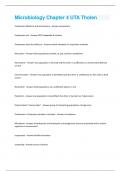
-
Microbiology Chapter 4 UTA Tholen Questions and Answers
- Exam (elaborations) • 6 pages • 2024
- Available in package deal
-
- £6.37
- + learn more
Prokaryotes (Bacteria and Archaea) are - Answer-everywhere. Prokaryotes are - Answer-VERY adaptable & resilient Prokaryotes have the ability to - Answer-switch metabolic or respiration methods Mutualism - Answer-both populations benefit; ex: gut nutrition metabolism Amensalism - Answer-one population is harmed and the other is unaffected; ex: antimicrobial defense on skin Commensalism - Answer-one population is benefitted and the other is unaffected; ex: Skin cells as food source Neutral...

-
RS/ REHS PRACTICE QUESTIONS WITH GUARANTEED CORRECT ANSWERS
- Exam (elaborations) • 53 pages • 2024
- Available in package deal
-
- £13.94
- + learn more
What is the most common cause of bacterial meningitis in children under five years of age? a) Neisseria meningitides b) Group B Streptococci c) Streptococcus pneumoniae d) Haemophilus influenzae type B - correct answer d) Haemophilus influenzae type B How is "giardiasis" usually transmitted to others? a) Person-to-person transfer of cysts from the feces of the infected individual b) Drinking unfiltered water from streams and lakes c) Drinking unboiled water from streams and lakes d)...
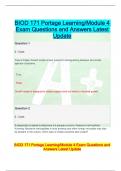
-
BIOD 171 Portage Learning/Module 4 Exam Questions and Answers Latest Update
- Exam (elaborations) • 17 pages • 2023
- Available in package deal
-
- £9.16
- + learn more
BIOD 171 Portage Learning/Module 4 Exam Questions and Answers Latest Update True or False: Growth media is best suited for distinguishing between two similar species of bacteria. True False Growth media is designed to simply support (and not restrict) microbial growth. A researcher is asked to determine if a sample contains Neisseria meningitides. Knowing Neisseria meningitides is slow growing and other foreign microbes may also be present in the culture, which typ...
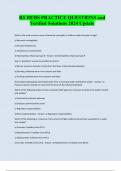
-
RS REHS PRACTICE QUESTIONS and Verified Solutions 2024 Update
- Exam (elaborations) • 48 pages • 2024
- Available in package deal
-
- £9.95
- + learn more
RS REHS PRACTICE QUESTIONS and Verified Solutions 2024 Update What is the most common cause of bacterial meningitis in children under five years of age? a) Neisseria meningitides b) Group B Streptococci c) Streptococcus pneumoniae d) Haemophilus influenzae type B - Answer -d) Haemophilus influenzae type B How is "giardiasis" usually transmitted to others? a) Person-to-person transfer of cysts from the feces of the infected individual b) Drinking unfiltered water from streams and lakes...
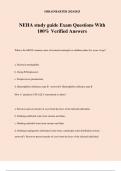
-
NEHA study guide Exam Questions With 100% Verified Answers
- Exam (elaborations) • 77 pages • 2024
-
- £9.16
- + learn more
NEHA study guide Exam Questions With 100% Verified Answers What is the MOST common cause of bacterial meningitis in children under five years of age? a. Neisseria meningitides b. Group B Streptococci c. Streptococcus pneumoniae d. Haemophilius influenzea type B - answerd. Haemophilius influenza type B How is "giardiasis USUALLY transmitted to others? a. Person-to-person transfer of cysts from the feces of the infected individual. b. Drinking unfiltered water from streams and lakes. c....
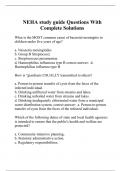
-
NEHA study guide Questions With Complete Solutions
- Exam (elaborations) • 57 pages • 2023
- Available in package deal
-
- £11.94
- + learn more
What is the MOST common cause of bacterial meningitis in children under five years of age? a. Neisseria meningitides b. Group B Streptococci c. Streptococcus pneumoniae d. Haemophilius influenzea type B correct answer: d. Haemophilius influenza type B How is "giardiasis USUALLY transmitted to others? a. Person-to-person transfer of cysts from the feces of the infected individual. b. Drinking unfiltered water from streams and lakes. c. Drinking unboiled water from streams and lake...

-
NEHA study guide Questions and Correct Answers | Latest Update
- Exam (elaborations) • 100 pages • 2024
- Available in package deal
-
- £10.83
- + learn more
What is the MOST common cause of bacterial meningitis in children under five years of age? a. Neisseria meningitides b. Group B Streptococci c. Streptococcus pneumoniae d. Haemophilius influenzea type B -:- d. Haemophilius influenza type B How is "giardiasis USUALLY transmitted to others? a. Person-to-person transfer of cysts from the feces of the infected individual. b. Drinking unfiltered water from streams and lakes. c. Drinking unboiled water from streams and lakes. d. Drinking...
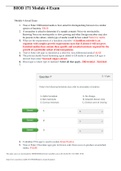
-
BIO 171 Module 4 Exam (100 OUT OF 100) Questions and Answers | Portage Learning
- Exam (elaborations) • 3 pages • 2022
- Available in package deal
-
- £8.76
- 2x sold
- + learn more
BIOD 171 Module 4 Exam Module 4 Actual Exam 1. True or False: Differential media is best suited for distinguishing between two similar species of bacteria. TRUE 2. A researcher is asked to dete rmine if a sample contains Neisseria meningitides. Knowing Neisseria meningitides is slow growing and other foreign microbes may also be present in the culture, which type of media would be best suited? Selective media. 3. What are the requirements of a fastidious microbe? A fastidious microbe is an organ...
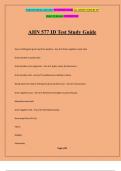
-
AHN 577 ID Test Study Guide
- Exam (elaborations) • 49 pages • 2024
-
- £9.95
- + learn more
AHN 577 ID Test Study Guide How to distinguish gram neg from positive - Ans:-Gram negative is pink stain Gram positive is purple stain Gram positive cocci organisms - Ans:-staph, strep, & Entrococcus Gram positive rods - Ans:-Corynbacerium, Bacillus, Listeria Broad spectrum empiric therapy for gram positive cocci - Ans:-Vancomycin Gram negative cocci - Ans:-Neisseria (meningitis or gonorrhoeae), Moxorella catarrhalis Gram negative rods - Ans:-Enterobacteriaciae, Normal gut flora (E Coli...
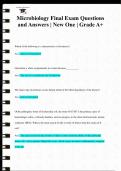
-
Microbiology Final Exam Questions and Answers | New One | Grade A+
- Exam (elaborations) • 12 pages • 2024
- Available in package deal
-
- £9.16
- + learn more
Which of the following is a characteristic of all enterics? Ans: glucose fermentation Gonorrhea is often asymptomatic in women because __________. Ans: The cervix is usually the site of infection The major sign of pertussis occurs during which of the following phases of the disease? Ans: paroxysmal phase Of the pathogenic forms of Escherichia coli, the strain O157:H7 is the primary cause of hemorrhagic colitis, or bloody diarrhea, and can progress to the often fatal hemolytic uremic sy...

£5.50 for your revision notes multiplied by 100 fellow students... Do the math: that's a lot of money! Don't be a thief of your own wallet and start uploading yours now. Discover all about earning on Stuvia


